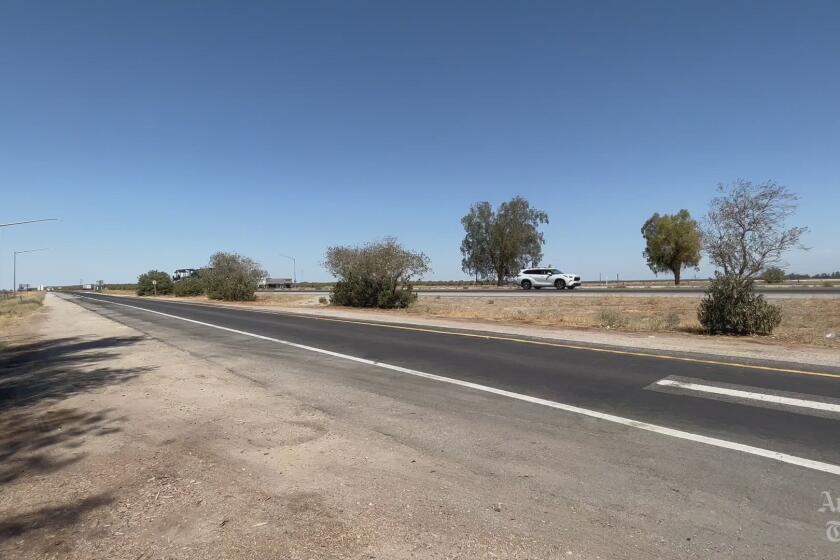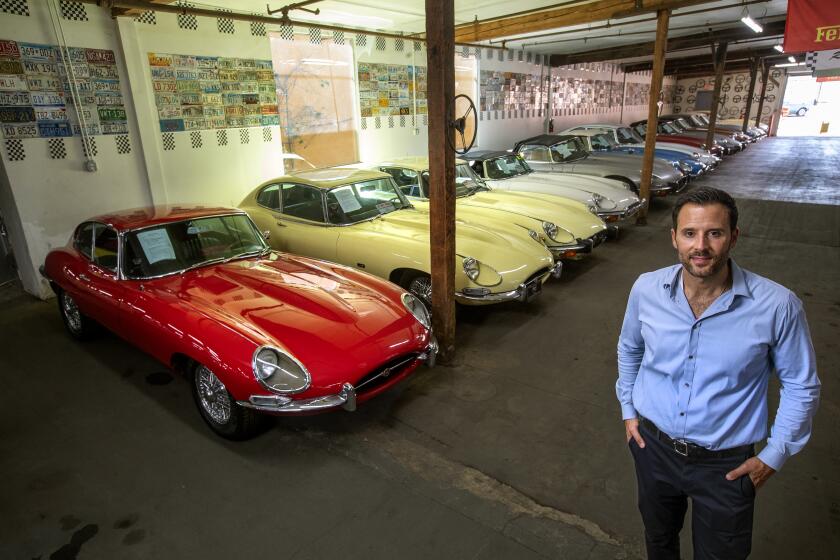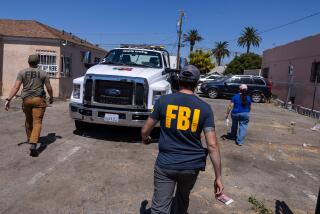Brink’s heist saga: How do you fence stolen gems worth millions? Inside the jewelry black market
For people who work in downtown L.A.’s frenetic jewelry district, St. Vincent Court — with its relaxed restaurants and Old World atmosphere — is a charming haven.
But on a recent afternoon, jewelers slouched in worn chairs outside of Le Cafe Bonjour considered an urgent question consuming their tightknit community: What happened to the goods stolen in the multimillion-dollar Brink’s heist?
As passersby offered greetings in Farsi and Hebrew, the jewelers — all of them men, most of them older — agreed on this: The thieves worked quickly to unload the pilfered merchandise, which could now be anywhere.
The theft occurred in July when a Brink’s big rig paused at a Grapevine truck stop while transporting jewelry from a Northern California trade show to the Southland.
Some of the jewelry might even be in L.A., perhaps in businesses just feet from the bricked alley between Broadway and Hill Street where the men were sitting, they said. The jewelers asked that their names not be published so they could speak frankly about their industry, including its unsavory side. It is likely, they said, that the bulk of the precious wares had been altered to make them unrecognizable.
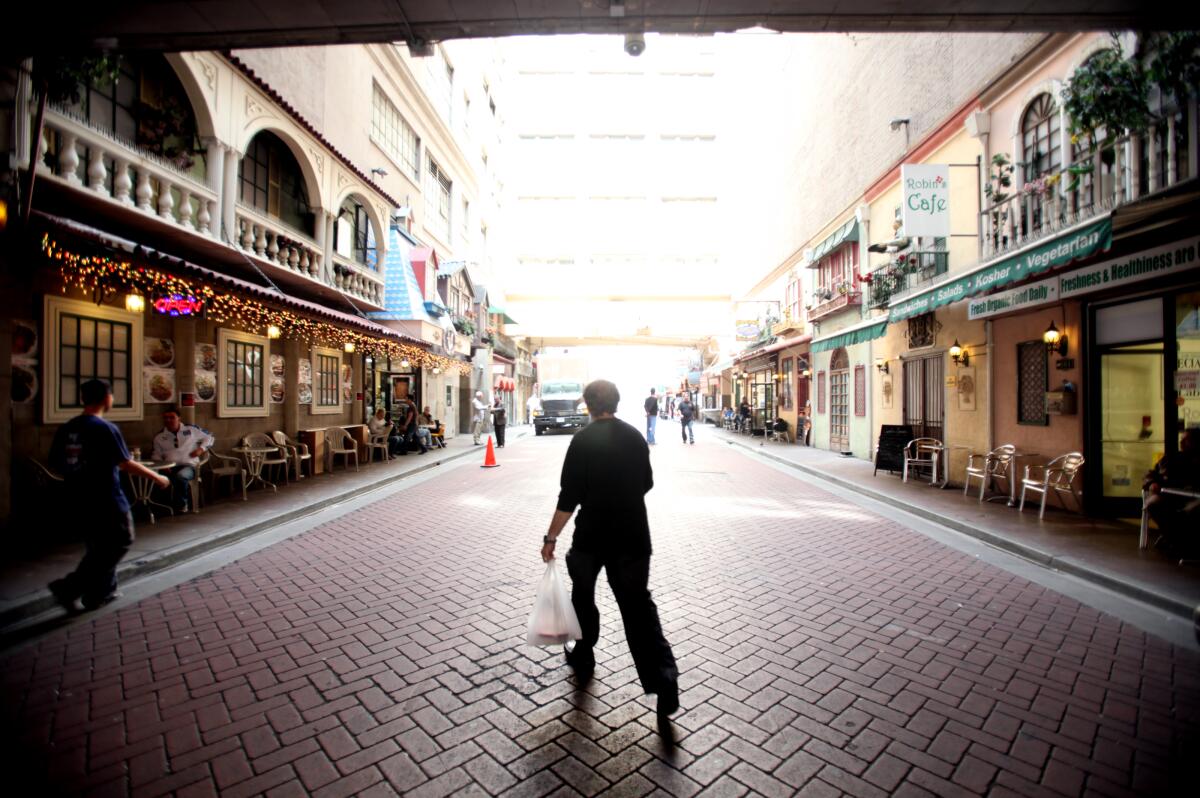
Other experts far from the quaint, tucked-away alley concurred, including an ex-jewel thief, and the writer of a book about an infamous 2003 diamond heist in Antwerp, Belgium, the epicenter of the trade.
“What you want to do is quickly sort and flip these items,” said Scott Andrew Selby, co-author of “Flawless: Inside the Largest Diamond Heist in History,” who added that “fungible” items such as loose diamonds would be unloaded first. “You could take them all to Antwerp and sell them in a day easy.”
At the center of such illicit trafficking are “fences” who buy ill-gotten wares and sell them to buyers who may, or may not, know the goods are stolen. Because fences allow thieves to dramatically lower their risk by offloading purloined goods, they often drive a hard bargain, acquiring items for a fraction of their value.
Some jewelry would be sold as is, though certain items could be so distinct that thieves might wait before trying to sell them. In any case, experts said, the thieves who carried out the late-night heist at the Flying J Travel Center in Lebec planned carefully.
Larry Lawton, a former jewel thief who spent more than a decade in prison after being convicted of racketeering in connection with jewelry store robberies in the 1990s, believes the thieves “knew where to get rid of the stuff before they” burgled the 18-wheeler.
A 298-mile drive in 2 hours and 4 minutes? The chronology described in a legal filing and law enforcement documents has added to the mystery surrounding the multimillion-dollar jewelry heist from a Brink’s truck.
“You don’t go into a robbery of this magnitude without having all your ducks in a row,” he said. “Whoever planned this ... planned a good one.”
Indeed, investigators believe the heist was carried out by sophisticated criminals, given the lack of violence and the speed of the operation, among other factors. When thieves broke into the Brink’s tractor-trailer shortly after 2 a.m. on July 11, one of the drivers was asleep in the vehicle’s sleeping berth and the other was getting food at the Flying J, the company has said.
Brink’s spokeswoman Dana Callahan said in a statement that the company is cooperating with the Los Angeles County Sheriff’s Department and wants “the criminals arrested and convicted, and the stolen goods returned.”

The heist victimized at least 14 jewelers, one of whom was among those theorizing at St. Vincent Court. As the scent of doner kebab perfumed the air, the jeweler said that after the incident, he showed photos of his missing wares to merchants at four or five stores in downtown L.A.
Nothing.
Grasping for clues, he visited a psychic duo, who told him the stolen items were “sitting in a warehouse, storage facility or garage.” It was, he conceded between sips of espresso, a futile endeavor.
“I don’t even believe” in psychics, he said.
Provenance erased
Although none professed firsthand experience with the dark arts of the business, the jewelers in St. Vincent Court described what they said were widely understood realities of their industry and explained how criminals might attempt to reintroduce ill-gotten merchandise into the marketplace.
Rings, bracelets, earrings and other pieces can be easily dismantled, either manually or by submerging them in a solution that’s used to “separate the gold and diamonds,” one jeweler said. Another man explained that the liquid, which he said is commonly referred to as “acid” — he didn’t know its chemical makeup — causes the precious metal to soften and detach from gems.
The conversation flowed, and the men nibbled at slices of Turkish honey cake the victim jeweler had purchased for the table.
Once jewelry has been broken down into its component parts, gold, platinum and silver can be melted and reconstituted as untraceable bars. Diamonds and other precious stones can be polished and re-cut to remove tiny inscriptions and other marks that tie them to registries kept by gemological laboratories.
Their provenance erased, the precious metals and gems could be sold to diamond dealers, pawnshops or disreputable jewelers, one of the men said. “The industry was and is very corrupt,” he added with a sharpness that momentarily punctured the languid ambience.
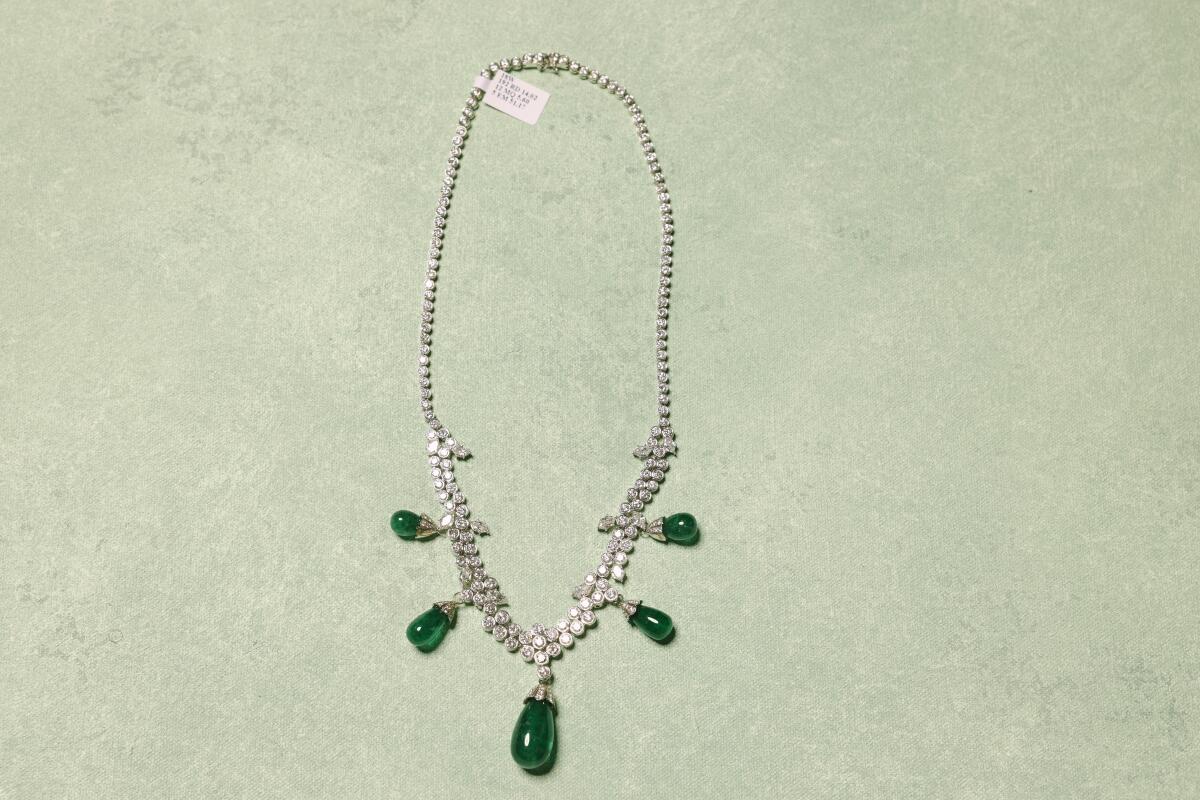
Reputable buyers, however, would cross-check a stone’s identifying information with one of a handful of laboratories’ databases before completing a purchase.
The biggest player in the space is the Gemological Institute of America, whose grading reports for diamonds are the industry standard. Stones authenticated by the GIA receive 10-digit numerical inscriptions that cannot be seen with the naked eye.
“Buying a diamond with a GIA report does give consumers the confidence that what they are receiving is what they intended to buy,” said Stephen B. Morisseau, the nonprofit’s director of corporate communications. (The GIA also inscribes rubies and sapphires, but not other colored stones.)
Headquartered in Carlsbad, the GIA works with authorities when they reach out regarding stolen diamonds. Did it get a request about the Brink’s heist? Morisseau declined to comment, saying: “We don’t discuss the details of any request.”
It took just 27 minutes to steal tens of millions in jewelry and gemstones from a Brink’s trailer in Lebec, Calif.
He acknowledged that the inscription on a diamond graded by the GIA “can be polished off ... without any loss of weight.” But it would still be difficult for a thief to resubmit a stone for GIA grading without it being detected.
Morisseau said the organization’s reports on diamonds are so detailed — the GIA tracks many measurements and characteristics, including the size, nature and placement of so-called inclusions — that it can identify a stone whose inscription has been removed and even its dimensions modified.
Yet he conceded that drastic alterations could mask a gem’s provenance.
“If you had a three-carat diamond and cut it down to a one-carat diamond, that would possibly evade our flagging — but you’d have a diamond that weighed far less,” Morisseau said. “Even if a diamond has been re-cut, we are confident we are able to identify the majority of them.”
Trafficking stolen material
London or Antwerp? Perhaps New York or Los Angeles.
The merchandise taken in the Brink’s heist could be in any number of locales — and the question of its whereabouts has bedeviled the affected jewelers.
Jerry Kroll, attorney for the victim jewelers, said many of them cannot avoid dwelling on the issue, which contributes to the intense “emotional distress they are going through.”
“It really is like playing a movie in your head over and over again, except each time the scenario changes,” he said. “For most of my clients, it is getting worse — given the enormity of the loss, the quantity of the goods taken. I can think of multiple scenarios, and they can, too. You wonder, what if the merchandise shows up in a pawnshop? You almost have to stop thinking about it, but that’s impossible because it’s their whole life.”
A jewelry designer at St. Vincent Court said that gold bars and loose diamonds could be sold in New York — which houses the country’s biggest diamond district — or Miami. “Lots of turnaround in Miami,” he said. “Business is good.”
Not all of the jewelry would be broken down and sold piecemeal. Items that are not recognizable “signature pieces” might be quickly resold, Lawton said. “You could unload this stuff at estate sales,” he said. “Some lady died — who can tell that lady didn’t have that brooch?”
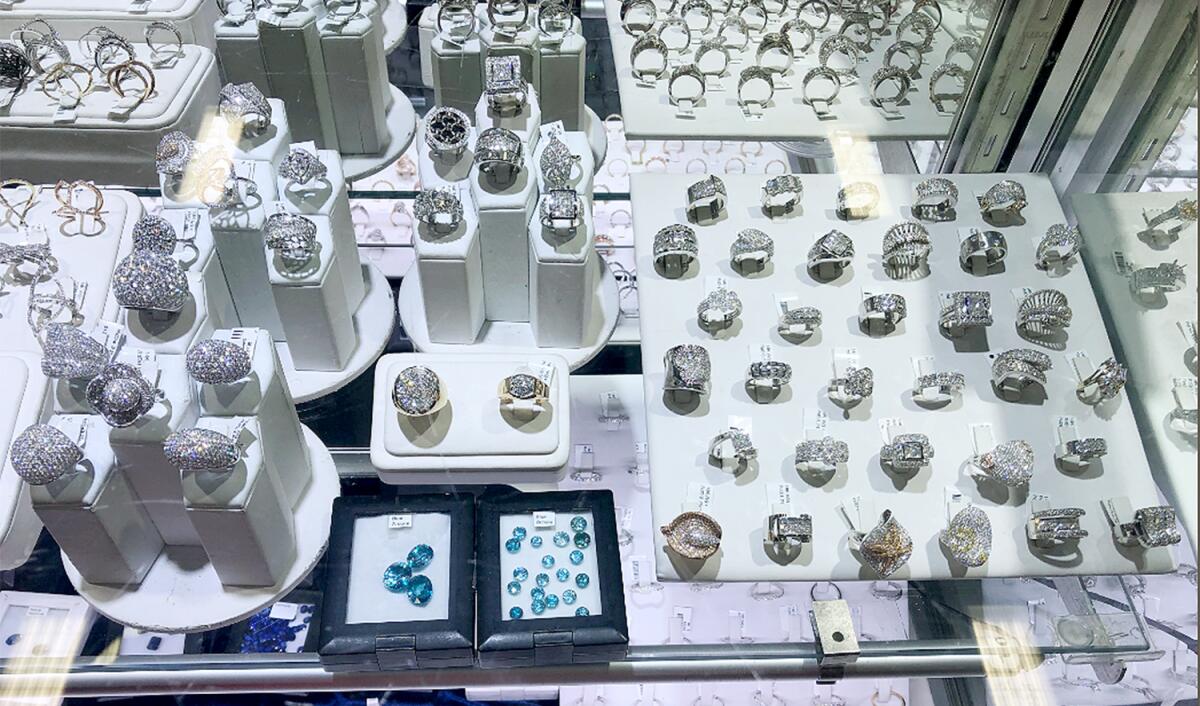
Lawton, however, cautioned that moving the stolen jewelry overseas presented additional risk.
“You are taking a big chance taking $100 million of stuff in suitcases,” he said. “Do they put it on a private plane? Customs does check those. Where do you take that kind of load? It’s a mega load.”
While a fence is typically involved in the dispersal of ill-gotten jewelry, in a highly sophisticated operation, the thieves may have the means to resell diamonds and gold themselves, Selby said.
It’s next to impossible to know whether any of the stolen items have been reintroduced to L.A.’s jewelry district, in part because of its vast size. Also, jewelers said that they wouldn’t know what to look for, noting that pictures of the missing merchandise haven’t circulated in the district, although the FBI has shared images of some purloined items with the news media.
Also among the cache of stolen items were hundreds of pricey wristwatches from companies including Rolex, Patek Philippe, Vacheron Constantin and Cartier.
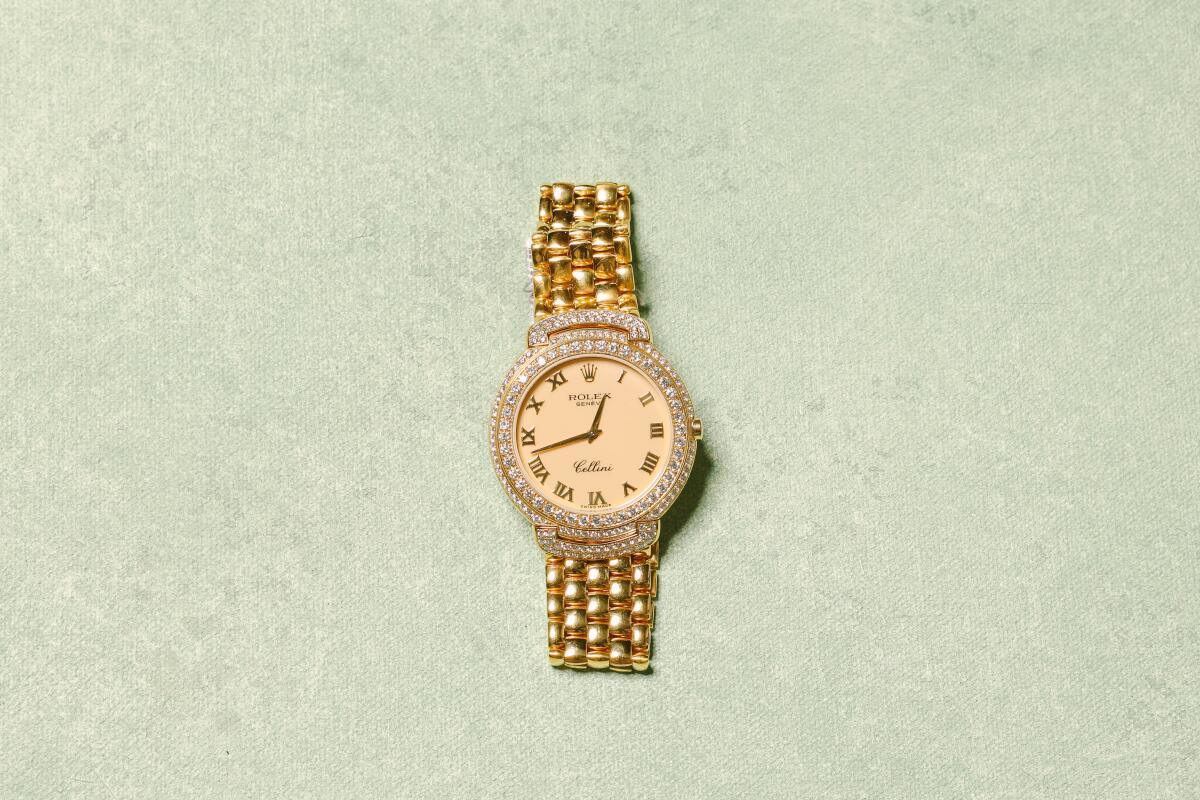
Watches can be stripped of their serial numbers and given new, fake ones. But some timepieces, including newer Rolexes, are marked with a serial number in tough-to-reach places, making it difficult to remove or replace them.
Still, there are some unscrupulous watch dealers willing to take on timepieces they know to be stolen, Lawton said. “I know enough jewelers that would take those Rolexes so quickly your head would spin,” he said. “Listen, I used to rob them all the time; I used to get a flat $2,000.”
Not every insider has a jaundiced view of the business. Jeremy Auslander, partner at L.A.-based Roxbury Jewelry, said that trust is a cornerstone of the industry, noting that jewelers “trade merchandise — tens of thousands of dollars — on a handshake.”
“Trust is what we have in this business. If you don’t have good credit — social credit, references — you will not survive in this industry,” Auslander said. “In this business, you can’t screw over other people.”
Suspicious wares peddled
Each of the jewelers in St. Vincent Court said that even as they run honorable businesses, they are exposed to the shadowy side of the industry on a regular basis.
One of the jewelers said that unscrupulous actors regularly peddle precious metals and gems, asking him, “Do you buy diamonds?”
“I don’t even look at it,” he said. “I say, ‘No.’ But there are people in the market looking for that.”
Said another jeweler based inside neighboring St. Vincent Jewelry Center: “Every day they come. I’ve never bought in my entire life. Certain people, that’s all they do.”
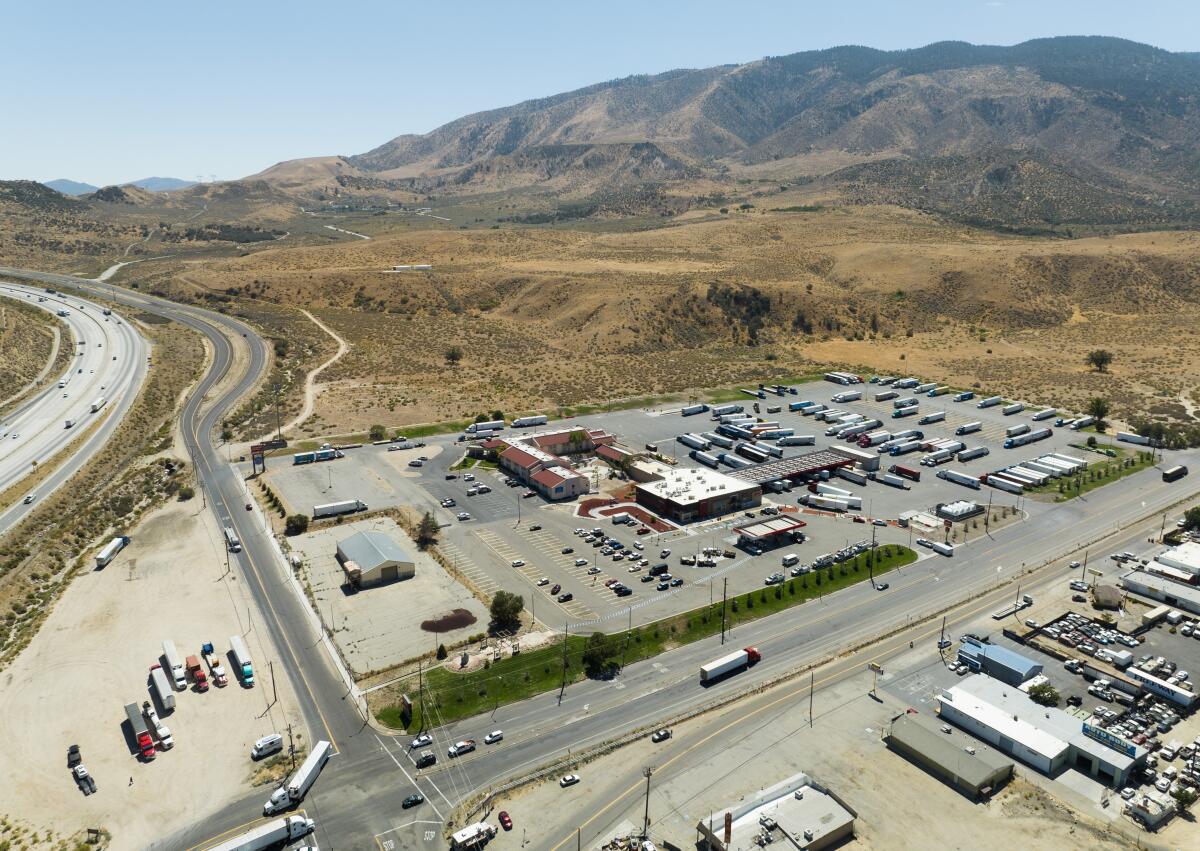
Two St. Vincent Court jewelers said there has been an uptick in this sort of unwelcome proffering over the last year or so — an increase that has coincided with the rise of smash-and-grab robberies at jewelry stores across the L.A. area. Not far from the alley, there was a startling example of such a crime — and an illustration of the risks jewelers face.
The St. Vincent Jewelry Center’s ground floor brims with the stores of dozens of merchants, including one whose display cases were badly damaged in September during a brazen smash-and-grab carried out by several men.
Beverly Hills Car Club and co-owner Alex Manos have built a following, but lawsuits accuse the dealership of selling vehicles with undisclosed damage, defective parts or other issues.
Asked about the incident, a jeweler recounted it with a nonchalance that seemed to underscore how pervasive the violence has become: Men in dark hooded sweatshirts used gloved hands to smash showcases while workers tried to fend off the attackers by throwing stools and other objects at them. The jeweler shared chilling security footage of the episode showing the center descend into chaos amid flying fists and shattered glass.
The takes in the smash-and-grab robberies are dwarfed by the haul in the Brink’s case — at least according to the jewelers’ estimates. They’ve pegged their total losses at about $100 million, but Brink’s has said the merchandise is worth less than $10 million. The disagreement is the subject of two ongoing lawsuits filed in August. This dispute isn’t the only one to arise out of the heist, with questions also mounting about the timeline of the mysterious crime.
Back at St. Vincent Court, the victimized jeweler finished his coffee quietly, the din of the jewelry district hushed by the tall buildings that hem in the alley. Nearby, pigeons patrolled the gutters as men huddled around a table littered with paper cups, a half-drunk bottle of Evian and a pack of Marlboro Golds. A Mercedes-Benz SL crept by. And every so often, someone would recognize the man whose merchandise was stolen.
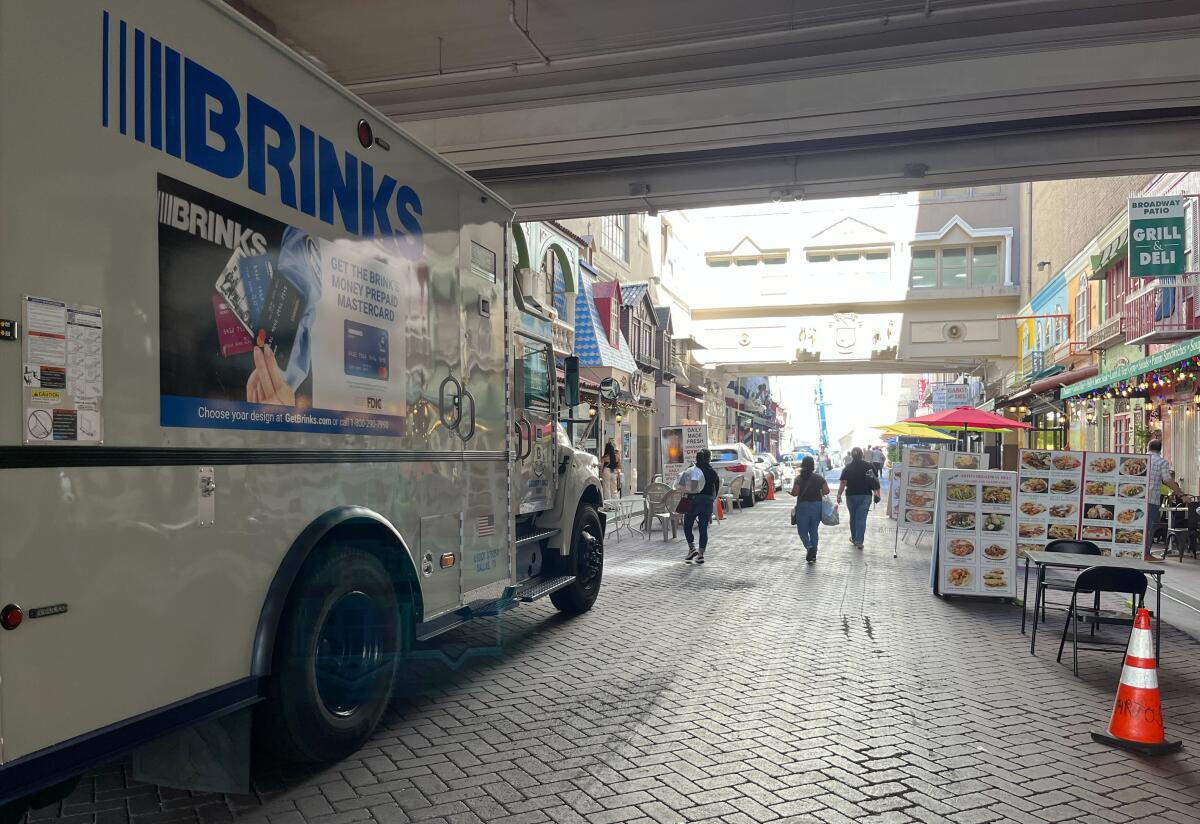
He got up to leave, walking toward the 7th Street entrance of St. Vincent Court, which is marked by a desecrated replica of the Statue of Liberty. Her robes were covered in graffiti, her lips marked with a slash of orange paint.
On this day, a curious vehicle idled next to the statue.
A Brink’s truck. A sign on its rear door read, “How’s my driving.”
Walking past the hulking vehicle, the victim jeweler could only offer a wry smile.
Watch L.A. Times Today at 7 p.m. on Spectrum News 1 on Channel 1 or live stream on the Spectrum News App. Palos Verdes Peninsula and Orange County viewers can watch on Cox Systems on channel 99.
More to Read
Inside the business of entertainment
The Wide Shot brings you news, analysis and insights on everything from streaming wars to production — and what it all means for the future.
You may occasionally receive promotional content from the Los Angeles Times.
